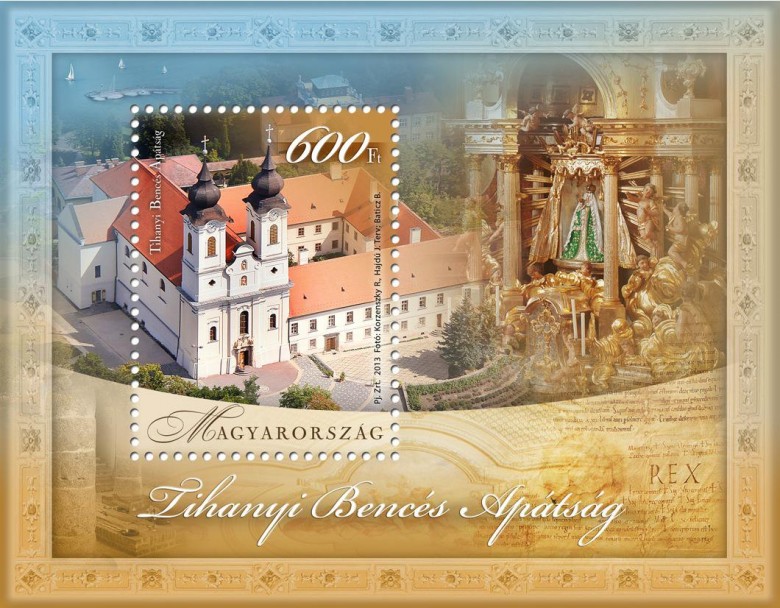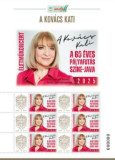
1. MAGYAR - TIHANYI BENCÉS APÁTSÁG - BÉLYEGBLOKK - Bélyeg rendelési kód: 2012 év bélyegei kompletten
2. ENGLISH - TIHANY BENEDICTINE ABBEY - Order code of the stamp: 2012 Year stamps complete
3. GERMAN - BENEDIKTINERABTEI TIHANY - Die Bestellnummer Der Marke: 2012 Jahr Briefmarken komplett
1. MAGYAR - TIHANYI BENCÉS APÁTSÁG - BÉLYEGBLOKK
Bélyegblokk köszönti az önállóvá vált Tihanyi Bencés Apátságot
A Tihanyi Bencés Apátság önállóvá válásának tiszteletére a Magyar Posta alkalmi bélyegblokkot bocsát forgalomba. A blokk bélyegképén madártávlatból a Tihanyi Bencés Apátság épületegyüttese látható. A keretrajz jobb oldalán az oltár részlete, alsó részén balra az altemplom, jobbra pedig az alapító okirat képe található. A sorszámozott blokkhoz tartozó alkalmi borítékon a balaton látképe, az alkalmi bélyegzőn pedig az épületegyüttes sziluettje tűnik elő.
A tihanyi bencés monostort I. András király 1055-ben alapította Szent Ányos és Szűz Mária tiszteletére. A hagyomány szerint Szent Ányos Orléans püspökeként imáival megmentette városát Attila hunjainak dúlásától, így tiszteletét a francia uralkodók évszázadokon át gondosan ápolták.
Nem tisztázott, miként került a szent tisztelete hazánkba, de bizonyosan az alapító királlyal hozható kapcsolatba. A középkori kolostor napjainkra szinte nyomtalanul eltűnt. Az alig tizenegynéhány kőfaragvány és a szinte érintetlenül ránk maradt XI. századi altemplom fennmaradása minden bizonnyal az itt eltemetett I. András tiszteletéhez kapcsolható.
Később, a török támadások miatt a szerzetesi élet megszűnt Tihanyban, a kolostorba katonák költöztek. Az épületegyüttes végvárrá vált, védelmi szempontok szerint átalakították. A török elleni felszabadító háborúk után a királyi kamara a felszabadított területeken álló birtokokat csak ún. fegyverváltság kifizetése után adta vissza egykori tulajdonosaiknak.
Tihanyért ezt a Magyarországi Bencés Rend nem tudta kifizetni, így 1702-ben az ausztriai Altenburg Bencés Apátság tulajdonába került. A Pannonhalmi Bencés Apátság 1716-ban vásárolta vissza. A templomot 1754-ben ideiglenesen, majd 20 évvel később véglegesen is felszentelték.
1786-ban II. József rendelete alapján a szerzeteseknek el kellett hagyniuk kolostorukat, csak egyetlen szerzetes maradhatott, aki ellátta a plébániai feladatokat. A rend tagjai 1802-ben térhettek vissza Tihanyba.
1889-1890 között az épületegyüttest teljesen felújították. 1950-ben ismét el kellett hagyniuk a szerzeteseknek a rendházat. A plébánia megmaradt, a rendházba először szegényház, később múzeum költözött. A Bencés Rend 1990-ben térhetett vissza Tihanyba, de a kolostor-együttest csak 1994-ben kapták vissza.
1992-ben elindult a templom belső restaurálása, amely 1996-ra fejeződött be. 1996-ban megkezdődött a kolostor teljes felújítása. (Forrás: tihany.osb.hu)
Forrás: Posta
2. ENGLISH - TIHANY BENEDICTINE ABBEY
The independent Tihany Benedictine Abbey is celebrated with a block of stamps
In commemoration of the independence of the Tihany Benedictine Abbey Magyar Posta is issuing a special block of stamps. On the stamp picture of the block the bird's-eye view of the building complex of the Benedictine Abbey of Tihany can be seen. On the right side of the frame drawing there is a part of the altar, at the bottom on the left there is a picture of the undercroft, and on the right there is a picture of the foundation document. On the special envelope that belongs to the serial numbered block there is the view of Lake Balaton, and on the special cancellation stamp the silhouette of the building complex can be seen.
The Benedictine monastery of Tihany was founded by King Andrew I in 1055, in honour of Saint Anianus and the Virgin Mary. According to legends Saint Anianus, being the bishop of Orleans, saved the city with his prayers from Attila the Hun, and his memory was cherished by French rulers for centuries. It is not clear how the saint became worshipped in Hungary, but it can be definitely associated with the founder king. By now the medieval monastery has disappeared completely. Very certainly the fact that a few stone carvings have remained and the undercroft from the 11th century has survived nearly untouched is due to the respect shown to Andrew I, who is buried here. Later on, because of the Turkish attacks monastic life in Tihany terminated, and soldiers moved into the monastery.
The building complex became a border fortress and it was reconstructed to suit the aspects of defence. After the liberating wars fought against the Turkish the royal chamber returned the lands on the liberated areas to their former owners only after they had paid a so-called ransom of arms. The Hungarian Benedictine Order could not pay this ransom for Tihany, so in 1702 it was transferred into the ownership of the Altenburg Benedictine Abbey of Austria. The Benedictine Archabbey of Pannonhalma bought it back in 1716. The church was consecrated in 1754 temporarily, and 20 years later it was consecrated finally. In 1786, on the basis of the order of King Joseph II the monks had to leave their monastery, only one monk was allowed to stay to perform the tasks of the parish. The members of the order could return to Tihany in 1802. In 1889-1890 the building complex was completely renovated. In 1950 the monks were forced to leave their friary again. The parish remained, but first a poorhouse and then a museum was moved into the friary. The Benedictine Order was allowed to return to Tihany in 1990, but it was only in 1994 that the monastery complex was given back to them. In 1992 the internal restoration of the church was started, and it was completed in 1996. In 1996 the complete renovation of the monastery was started. (Source: tihany.osb.hu)
3. GERMAN - BENEDIKTINERABTEI TIHANY
Ein Briefmarkenblock grüßt die unabhängig gewordene Benediktinerabtei von Tihany
Die Magyar Posta bringt zu Ehren der Unabhängigkeit der Benediktinerabtei Tihany einen Sonderbriefmarkenblock in Umlauf. Auf den Briefmarken des Blocks ist das Gebäude der Benediktinerabtei Tihany aus der Vogelperspektive zu sehen. Auf der Rahmenzeichnung erscheinen rechts ein Detail des Altars, unten links ist die Krypta und unten rechts ist das Bild der Gründungsurkunde abgebildet. Auf dem zum Briefmarkenblock gehörigen Sonderumschlag ist der Blick auf den Balaton und auf dem Sonderstempel die Silhouette des Gebäudes zu sehen.
Das Benediktinerkloster Tihany wurde im Jahre 1055 von König Andreas I. zu Ehren von St. Aignan und der Jungfrau Maria gegründet. Nach der Tradition rettete der Heilige Anianus (Aignan), Bischof von Orléans, mit seinen Gebeten die Stadt vor der Verheerung der Hunnen unter Attila, deswegen wurde sein Andenken von den französischen Herrschern über Jahrhunderte hinweg sorgfältig gepflegt. Es ist nicht klar, auf welche Weise die Verehrung des Heiligen in unsere Heimat gelangte, aber sicherlich ist dies mit dem den Staat gründenden König verbunden. Das mittelalterliche Kloster ist inzwischen fast spurlos verschwunden. Die ungefähr zehn Steinmetzarbeiten und die Erhaltung der fast unberührt gebliebenen Krypta aus dem 11. Jahrhundert ist sicherlich mit der Ehrung des hier begrabenen Königs Andreas I. verbunden. Später, zur Zeit der türkischen Angriffe endete das klösterliche Leben in Tihany, Soldaten zogen in das Kloster ein. Der Gebäudekomplex wurde zur Festung und den Schutzkriterien angepasst. Nach den Befreiungskriegen gegen die Türken hat die königliche Kammer die Besitztümer in den befreiten Gebieten nur nach Zahlung eines sog.
Waffenlösegeldes an die ehemaligen Eigentümer zurückgegeben. Der Benediktinerorden Ungarns konnte dieses Lösegeld für Tihany nicht aufbringen und so gelangte es 1702 in das Eigentum der österreichischen Benediktinerabtei Stift Altenburg. 1716 wurde es von der Benediktinerabtei Pannonhalma zurückgekauft. Die Kirche wurde 1754 vorübergehend und 20 Jahre später endgültig eingeweiht. 1786 mussten die Mönche ihr Kloster auf Grund des Erlasses von Joseph II. verlassen, nur ein einziger Mönch durfte bleiben, der die Aufgaben der Pfarrei besorgte. 1802 konnten die Ordensmitglieder nach Tihany zurückkehren. Zwischen 1889-1890 wurde das Gebäude komplett renoviert. 1950 mussten die Mönche das Kloster noch einmal verlassen. Die Pfarrei blieb, in das Kloster zog erst ein Armenhaus, später ein Museum. 1990 durfte der Benediktinerorden nach Tihany zurückkehren, aber das Kloster bekam er erst 1994 wieder. 1992 begann die Restaurierung des Inneren der Kirche, die 1996 abgeschlossen wurde. 1996 begann die komplette Renovierung des Klosters. (Quelle. tihany.osb.hu)










